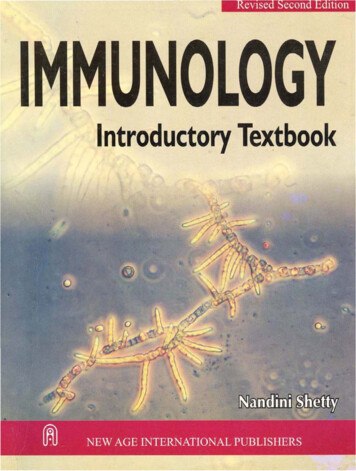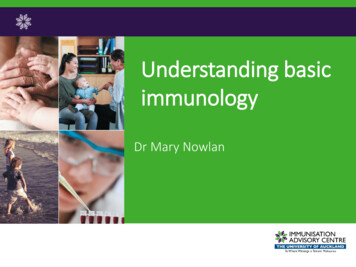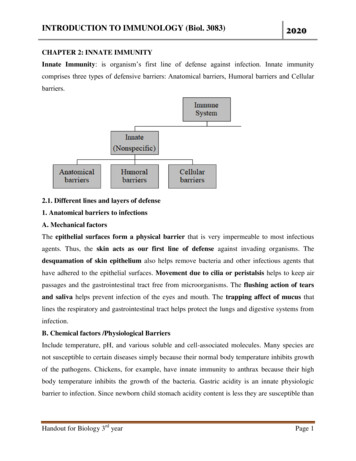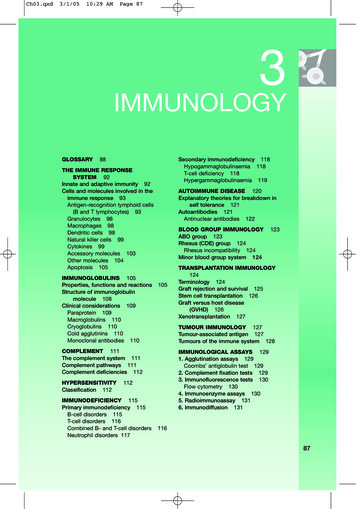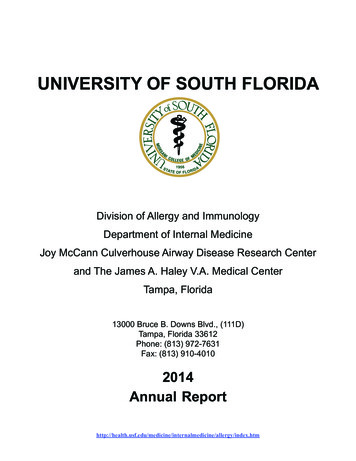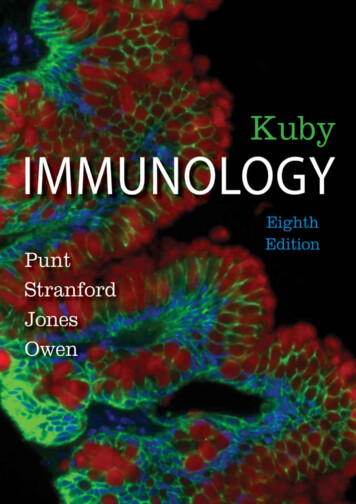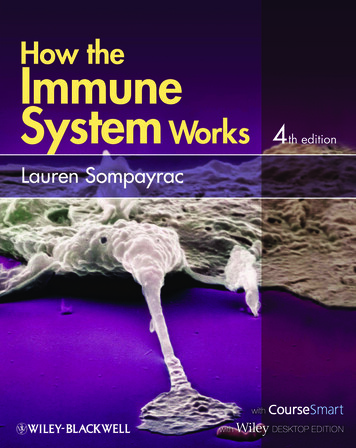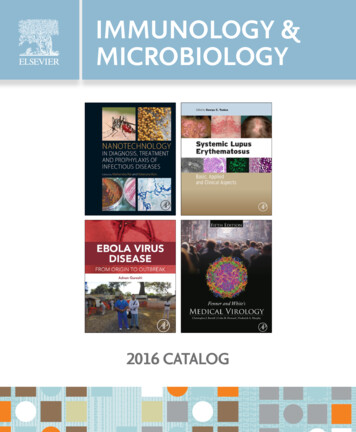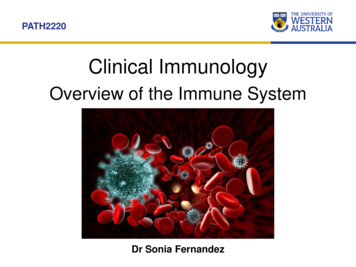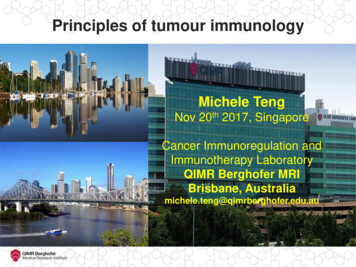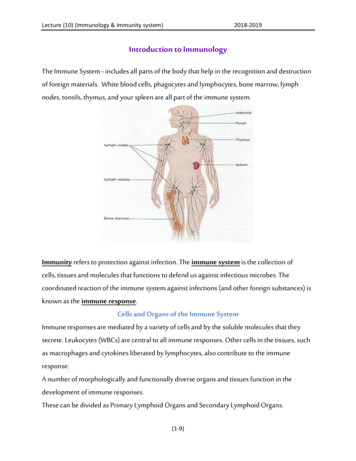
Transcription
Lecture (10) (Immunology & immunity system)2018-2019Introduction to ImmunologyThe Immune System - includes all parts of the body that help in the recognition and destructionof foreign materials. White blood cells, phagocytes and lymphocytes, bone marrow, lymphnodes, tonsils, thymus, and your spleen are all part of the immune system.Immunity refers to protection against infection. The immune system is the collection ofcells, tissues and molecules that functions to defend us against infectious microbes. Thecoordinated reaction of the immune system against infections (and other foreign substances) isknown as the immune response.Cells and Organs of the Immune SystemImmune responses are mediated by a variety of cells and by the soluble molecules that theysecrete. Leukocytes (WBCs) are central to all immune responses. Other cells in the tissues, suchas macrophages and cytokines liberated by lymphocytes, also contribute to the immuneresponse.A number of morphologically and functionally diverse organs and tissues function in thedevelopment of immune responses.These can be divided as Primary Lymphoid Organs and Secondary Lymphoid Organs.(1-9)
Lecture (10) (Immunology & immunity system)2018-2019Primary Lymphoid Organs include (Thymus and Bone marrow)Secondary Lymphoid Organs include (Tonsil, Lymph node, Spleen, Peyer’s patches, Appendixand Tissue lymphatic )The immune system is typically divided into two categories innate and adaptiveInnate immunity (non specific immunity) Innate Immune System / First-Line Defenses - The body's first line of defense againstpathogens uses mostly physical and chemical barriers such as Skin – acts as a barrier to invasion Sweat – has chemicals which can kill different pathogens. Tears - have lysozyme which has powerful digestive abilities that render antigensharmless. Saliva – also has lysozyme. Mucus - can trap pathogens, which are then sneezed, coughed, washed away, ordestroyed by chemicals. Stomach Acid – destroys pathogens Second-Line Defenses - If a pathogen is able to get past the body's first line of defense,and an infection starts, the body can rely on its second line of defense. This will result inwhat is called an Inflammatory response causes Redness - due to capillary dilation resulting in increased blood flowHeat - due to capillary dilation resulting in increased blood flowSwelling – due to passage of plasma from the blood stream into the damaged tissuePain – due mainly to tissue destruction and, to a lesser extent, swelling.(2-9)
Lecture (10) (Immunology & immunity system)2018-2019Adaptive (Acquired) immunity (Specific Mechanisms of Defense)Adaptive immunity refers to antigen-specific immune response. The adaptive immune responseis more complex than the innate. Third-Line Defenses - Sometimes the second line of defense is still not enough and thepathogen is then heading for the body's last line of defense, the immune system. The immune system recognizes, attacks, destroys, and remembers each pathogen thatenters the body. It does this by making specialized cells and antibodies that render thepathogens harmless. Unlike the first line and second line defense the immune system differentiates amongpathogens. For each type of pathogen, the immune system produces cells that are specific for thatparticular pathogen.(3-9)
Lecture (10) (Immunology & immunity system)2018-2019Active Immunity or Passive ImmunityActive immunity is the resistance developed by an individual, as a result of an antigenicstimulus. This involves the active functioning of a person’s immune system, leading to thesynthesis of antibodies and/or the production of immunologically active cells. Active immunitysets in only after a latent period, which is required for the immunological machinery to be set inmotion.The resistance that is transferred to a recipient in a ready-made form is known as passiveimmunity. Here, the recipient’s immune system plays no active role. There is no antigenicstimulus. Instead, pre-formed antibodies are administered.(4-9)
Lecture (10) (Immunology & immunity system)2018-2019AntigenAny substance (usually foreign) that binds specifically to an antibody, or a T cellreceptor, is referred to as an ‘antigen’.A substance capable of inducing a specific immune response is called an antigen. Antigens are macromolecules that elicit an immune response in the body. The mostcommon antigens are proteins and polysaccharides.Antigens can enter the body from the environment. These include inhaled macromolecules (e.g., proteins on cat hairs that can trigger an attack of asthmain susceptible people) ingested macromolecules (e.g., shellfish proteins that trigger an allergic response insusceptible people) molecules that are introduced beneath the skin (e.g., on a splinter or in an injectedvaccine)(5-9)
Lecture (10) (Immunology & immunity system)2018-2019Antigenic determinants.The chemical groups on the antigen molecules that determine their immunogenicity are calledantigenic determinants, also known as epitopes. Antigenic determinants may consist ofseveral amino acids of a protein molecule or several monosaccharide units of a polysaccharide.Each species of living thing is chemically and antigenically unique because of differences in itsproteins, carbohydrates, and other organic substances.Types of antigens. Certain types of antigens are distinctive. Autoantigens, for example, are aperson's own self antigens. Alloantigens are antigens found in different members of the samespecies (the red blood cell antigens A and B are examples). Heterophile antigens are identicalantigens found in the cells of different species.AntibodyA protein (immunoglobulin) that recognizes a particular antigen and bindsspecifically to it is called an ‘antibody’.Antibodies are produced by B cells.* Classification of Antibodies (Immunoglobulins)* Immunoglobulin M (IgM)* Immunoglobulin G (IgG)* Immunoglobulin A (IgA)* Immunoglobulin D (IgD)* Immunoglobulin E (IgE)(6-9)
Lecture (10) (Immunology & immunity system)2018-2019Humoral and Cellular ImmunityThe immune system comprises of two parallel, but interrelated, systems: these are:Humoral immune response and Cellular immune response.In the humoral immune response, soluble proteins called antibodies (immunoglobulins)function as recognition elements and they bind specifically to antigens. Antibodies are secretedby plasma cells that are derived from B-lymphocytes (B cells).In the cellular immune response, cells called cytoxic T- lymphocytes kill cells that display foreignmotifs on their surfaces. The cellular immune response is mediated by specific receptors that areexpressed on the surface of the T cells.Another class, called helper T-lymphocytes, contributes to both humoral and cellular immuneresponses by stimulating the differentiation and proliferation of appropriate B cells and T cells.The site of infection and type of pathogen largely determine which immune response will beeffective.(7-9)
Lecture (10) (Immunology & immunity system)2018-2019Immunization- Passive immunization (patient is given preformed antibodies form ofimmunotherapy) Active immunization (patient is vaccinated with a microbe or its antigens providing aform of advance protection)DISORDERS OF THE IMMUNE SYSTEM1- Hypersensitivity Reactions* Over-reaction of adaptive immune response to harmless antigens* Four Types of reactions (I- IV)2- Autoimmunity* Misdirected adaptive immune response* Results from a loss of self-tolerance* Three Types (II, III, IV) of reactions3- Immunodeficiencies* Components of immune system either absent or defective* Genetic or acquired etiologyHypersensitivityDisorders caused by pathologic immune responses are called hypersensitivity diseases.This term is derived from the idea that an individual who has previously encountered anIntroduction to Immunology.antigen is “sensitive” to a second encounter with that antigen (i.e. mounts a strongerresponse upon the second encounter); “hypersensitivity” denotes an abnormal, orpathologic, reaction. There are four types of hypersensitivity, which differ in theirpathogenesis, effector mechanisms, and clinical and pathological manifestations.(8-9)
Lecture (10) (Immunology & immunity system)2018-2019Types of hypersensitivity diseases. (It is preferable to use the descriptiveterms rather than the less informative numerical classification.)(9-9)
Lecture (10) (Immunology & immunity system) 2018-2019 (1-9) Introduction to Immunology The Immune System - includes all parts
